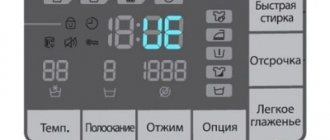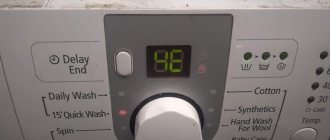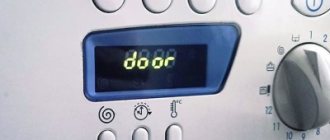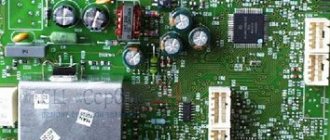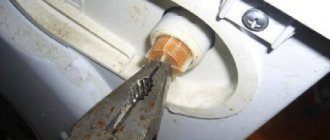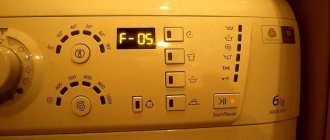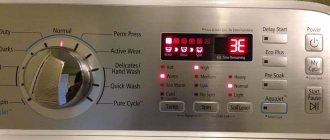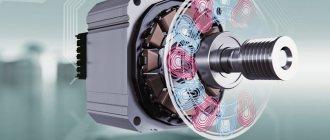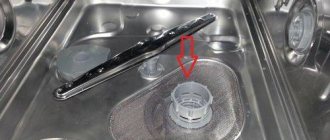Washing dishes every day is not only not the most pleasant task, it also requires a huge amount of time. This has become the reason for the increased demand for high-quality dishwashers that will effectively cope with their task and help housewives. Many people believe that if a thing is expensive, this means that it is of high quality and will work well for a long time. This is a misconception, since incorrect operation of any product can lead to malfunctions, breakdowns or even destruction.
The average person does not always know how to correct errors that occur in devices and equipment. When you don’t know what to do or what to do, it’s better to seek help from real professionals who will tell you what to do or do the repair work themselves. Expert advice can help you eliminate minor defects yourself. And in Bosch brand machines, if error e15 occurs, you can handle it alone, without additional consultation.
Error E15 in a Siemens dishwasher
Is there an E15 error in your Siemens dishwasher?
This means that the self-diagnosis system responded to a breakdown—a leak. Siemens dishwashers feature modern technologies and programs. The electronic board controls all processes in the machine, so as soon as a problem occurs, the system displays an error code on the display. By learning its meaning in more detail, you can quickly troubleshoot the problem.
Frequent causes of breakdowns
For equipment with an electronic display, the causes of malfunctions in the form of codes are displayed on the screen. The instructions for the equipment tell you what to do if a particular error occurs. But in some cases, independent repair is impossible. The difficulty is that most of the Neff dishwashers are built-in; they must be disassembled to find the breakdown. In addition, special diagnostic devices are needed.
It is better to entrust Neff dishwasher repair at home to a professional who will promptly detect the breakdown and offer a solution.
The most common malfunctions:
clogging of hoses and valves, which is why the machine does not draw or drain water;- burnout of the heating element, as a result of which the water does not heat up;
- failure of temperature, flow, flow or water turbidity sensors.
Solving problems often requires installing new pumps, valves, and sensors. You can also replace the heating element and control unit.
Dishwashers of considerable age have natural problems associated with wear and tear. For example, it is necessary to replace cuffs and loops. Install new knobs, buttons, indicators. All this work is done quickly and is inexpensive, much cheaper than the cost of a new dishwasher.
Sometimes what is needed is not repairs with the replacement of components, but cleaning, adjustment, and tuning of equipment.
Why does PMM give an error?
The E 15 icons on the display indicate that the Aquastop protection has been activated (the explanation is also indicated in the instructions). In this case, the equipment turns off and can emit a sound signal. The protection system is triggered when water overflows or leaks. You may hear the sump pump start to remove water, but the control panel will not respond.
What to do in this case? We need to find the cause of the problem. To do this you need to check:
Why else could the dishwasher show a fault code? The cause could be an incorrectly selected detergent. Excess foam leads to leaks and errors.
Possible causes and their elimination
Error E15 in a Bosch dishwasher can appear for several reasons. It could be:
- malfunction of the dishwasher control unit;
- “sticking” of the float of the protective system;
- malfunction of the sensor signaling a leak;
- clogged filter, drain hose or pipe, pump;
- violation of the sealing of 1 of the pipes in the PMM housing;
- malfunctions in the operation of the spray arm that washes the dishes.
In addition to the problems that have already been listed, there may be one more problem - exceeding the recommended amount of detergent. This leads to excessive foaming and ultimately to the activation of the Aquastop protection. Let's look at how you can fix the problem by repairing the dishwasher yourself.
How to fix the problem
Rule out a system failure by rebooting the machine and clearing the error. To do this, disconnect the equipment from the network for 10-15 minutes, then connect it again. If the code is still displayed on the screen, then proceed to check.
You can find out if there was actually a leak like this:
If the problem is a leak, you need to locate the leak as soon as possible. To do this, remove the top and back panels, connect the dishwasher to water and electricity and do a test run.
Now all that remains is to observe where the water starts to drip from. Found a faulty part? Turn off the equipment again and start repairing.
How to fix the situation if a metal bin is leaking? You can try to seal the crack with cold welding. Just prepare the surface first: clean and degrease. In severe cases, you will have to buy new equipment.
Timely cleaning of the filter is the prevention of leakage. When the filter becomes heavily clogged, excess pressure develops in the pipes, causing them to rupture. Cleaning should be carried out at least twice a month. How to do it:
Source
Clogged drain system
Error E15 in a Bosch dishwasher may appear if:
- the filter is clogged with grease and food waste;
- the drain hose or pipe is clogged or depressurized;
- there is a blockage in the sewer.
Failure to clean the filter element in a timely manner is one of the common reasons that leads to the appearance of fault code E15. Restore the filter to functionality as follows:
- unplug the dishwasher;
- remove the lower basket for dishes from the chamber;
- unscrew the cap located next to the lower spray impeller;
- remove the filter element from the niche;
- wash the filter using any household detergent to remove grease deposits;
- Reinstall the cleaned filter.
So, the filter is cleaned. If, after removing the water from the pan and restarting, the E15 fault code still appears, you need to check whether the drain pipe is leaking.
To do this, you will have to disassemble the Bosch PMM in this order:
- Disconnect the unit from the power supply by removing the power plug from the socket.
- Remove the filter that was previously cleaned from the niche.
- Remove the left and right housing covers by unscrewing them with a screwdriver.
- Turn the PMM over so that the bottom is at the top.
- Remove the front panel by unscrewing the bolts on the left and right sides of the case. To do this, you may need a screwdriver with a torx bit.
- The metal strip that will open after removing the panel must also be removed. To do this, unscrew the screws that secure it to the body.
- Unscrew and remove the bolts located in the back wall of the dishwasher.
- Disconnect the rubber clamps holding the pump to the bottom of the PMM.
- Remove the two plugs on the sides of the case; they should be made of plastic.
- Disconnect the door holder from the body.
- Remove the lower part of the housing, first removing the rope from the spring.
- Disconnect the drain hose from the pump and check its integrity. Clean under strong water jet. Replace if necessary. The same must be done with the pipe, removing the mounting clamps.
- Reassemble in reverse order.
If you have doubts about your ability to independently cope with the disassembly and assembly of the PMM, call a specialist. He will quickly find the cause and eliminate the damage.
How to fix error E15 in Bosch and Siemens dishwashers
For some brands of dishwashers Bosch, Neff and Siemens, produced by the same concern, error E15 is interpreted in the same way. It is caused by the activation of leakage protection. First, you need to inspect the device to see if a software glitch is causing it. After this, you can begin troubleshooting. Often the faults turn out to be simple and can be easily fixed by users themselves.
Most modern dishwashers have an AquaStop system: when 0.2 liters of water accumulates in the dishwasher tray, the operation of the equipment is suspended. This program is designed to protect the user from depressurization and leaks of the hose, overflow of liquid, the excess amount of which is directed into the vessel. It is the activation of this protection mechanism that error E15 should signal.
When the volume exceeds 200 ml, the level sensor is triggered: the control float floats up and closes the contacts of the electricity switch that supplies the water supply valve.
Bosch dishwashers rarely show error E15.
Algorithm for eliminating error E15 in a dishwasher:
After completing the restoration procedures, operation of the PMM is resumed in normal mode. Following the rules of use and using recommended detergents will help you avoid a recurrence of the problem.
Problems in the operation of PMMs appear not only from breakdowns, but also from software failures. In such cases, self-diagnosis of the household appliance is launched: a special code is displayed on the display, which is deciphered in the technical passport of the machine. Immediately after this, testing begins and an error code appears on the screen, in this case E15. The causes of the malfunction are:
After establishing the true cause of the E15 error in the dishwasher, you will need to reset the used position - reset the display screen. There are two ways: the first is to simply disconnect the PMM power cord from the power supply and wait 20 minutes. After this, the PMM can be turned on, since the settings will already be reset. The second option is even faster - press and hold the start button in this position for 20 seconds.
The most common damage
Float stuck
One of the possible reasons for the appearance of error code E15 on the display is the sticking of the float located in the pan. If this is indeed the case, fixing the problem is not difficult. Disconnect the PMM from the power supply by removing the power plug from the socket. Rocking, moving from place to place (preferably so that the body vibrates) or tilting the body at an angle of 30-40° to one side will help correct the situation. True, such manipulations are not easy to do if the equipment is built into the furniture.
Be careful as a strong tilt will cause water to leak from the pan onto the floor. This method often helps restore normal system operation. Finally, you need to tilt the machine enough to completely drain the water from the pan.
Do not rush to turn on the unit immediately. It is necessary to dry the pallet, which takes about a day. You can carefully use a hairdryer, then the PMM will dry very quickly. If, when turned on again, the alphanumeric combination E15 disappears, then the problem has been resolved. Otherwise you will have to deal with more serious damage.
Excess detergent
Excess detergent can lead to excessive foaming and error code E15, so detergent must be dosed strictly.
Fixing error e15 in the dishwasher
Washing dishes every day is not only not the most pleasant task, it also requires a huge amount of time. This has become the reason for the increased demand for high-quality dishwashers that will effectively cope with their task and help housewives. Many people believe that if a thing is expensive, this means that it is of high quality and will work well for a long time. This is a misconception, since incorrect operation of any product can lead to malfunctions, breakdowns or even destruction.
The average person does not always know how to correct errors that occur in devices and equipment. When you don’t know what to do or what to do, it’s better to seek help from real professionals who will tell you what to do or do the repair work themselves. Expert advice can help you eliminate minor defects yourself. And in Bosch brand machines, if error e15 occurs, you can handle it alone, without additional consultation.
How are Neff fault codes deciphered?
The NEFF dishwasher malfunction warning system does not have a standard set of codes. Each model may have its own. Therefore, we included in the list all possible combinations of letters and numbers that may appear on the display of any PMM model of the Neff brand.
Let's consider the meaning of the codes available to the user without test (service) mode:
- E01, E05 - in both cases the problem is in the control module. You will need the help of a technician to further diagnose the device.
- E1 - lack of heating due to a problem with the sensors or electronics. It is also possible that there is a short circuit or an open circuit in the heating element circuit.
- E02, E04 - the water does not heat up due to an electronics failure. If error E02 occurs, the heater relay on the control board is most likely broken.
- E2 - the temperature sensor (NTC) is broken. In most cases, the part must be replaced.
- E03 - additional drying is faulty. Reasons: the heating element relay has broken (responsible for its operation), a contact in the circuit has come loose, or the wire itself has broken.
- E3 - problem with water intake: the PMM tank takes longer to fill than the set time. This happens when there is insufficient pressure in the water supply or the supply tap is turned off. The pipes, inlet valve may be clogged, or the chamber door may not be closed tightly. More serious problems, such as a breakdown of the intake solenoid valve, pressure switch or controller, should be repaired by a specialist.
- E4 - failure of the flow sensor (switch), which is responsible for the distribution of water in the sprinklers. It may not work properly either due to blockage or if the circuit is broken.
- E5 - excess water level in the chamber. This happens when the drain system is clogged or damaged. The pressure switch or inlet valve may also be faulty.
- E06 - failure of the camera door position sensor. The start of the wash is blocked because there is no signal that the door is closed. The cause may be a broken door lock, which is easy to fix yourself. If the sensor is broken, it will have to be replaced.
- E6, E28 - malfunction of the aquasensor, which checks the quality of the water when rinsing. The control module or the sensor itself may be faulty. The latter needs to be replaced.
- E07 - drain does not work. The reason is improper loading of dishes, which may block the hole for the outflow of liquid.
- E08, E8 - low water level in the chamber. The heating element will not turn on because the circulation pump does not have enough water. The reason must be sought in the incorrect installation of the latter or a violation of the installation of the drain hose.
- E09, E9 - malfunction of the heating element. Perhaps the wire has broken or the contact in the heating element circuit has come loose. If it burns out, the part will have to be replaced.
- E10 - drying does not start due to a malfunction of the heating element or fan.
- E11 - the temperature sensor is broken. In this case, it either does not work at all or shows incorrect data. It is necessary to check the circuit and inspect the contacts. If the thermistor is broken, it is replaced.
- E12 - poor drying or insufficient heating. Most likely, the heating element is overgrown with a layer of scale and this prevents it from functioning correctly.
- E13 - indicates the flow of too hot water (over 75 °C) due to a breakdown of the temperature sensor.
- E14 - water flow sensor error. The reasons are standard: the circuit has broken, the contacts have come loose, or the part itself has broken.
- E15 - the Aquastop leak protection system has activated. It is necessary to find the location of the leak: check the hoses, housing and other components of the PMM for damage. If the drain pump itself is leaking, a new part is installed.
The error may appear after the control module has been replaced. Try rebooting your device. (How to restart the PMM, read after the list of errors.)
- E16 - leaking valves or sensors. It is necessary to inspect the PMM components for leaks. Damaged parts are best replaced.
- E17 - flood error (associated with strong pressure or overflow). It is necessary to check the pressure in the water supply and reduce it. The pressure switch or fill valve may be broken.
- E18 - low water level in the tank. Most likely, the inlet valve has broken, but the error may also indicate the problems described in codes E3 and E14.
- E19 - means internal error. You need to contact the service center.
- E20, E21 - the circulation pump is not functioning or is blocked. The malfunction is associated either with an open circuit in the pump motor, or with a breakdown of the tachogenerator or capacitor. Then they will need to be replaced.
- E22, E24, E25 - problems with drainage. The filter (or drain hose) may be defective or clogged. It is necessary to exclude incorrect connection of the latter, as well as failure of the drain pump.
- E23 - the drain pump is broken. You can check the pump blades for foreign objects that may be blocking the pump's operation. If the part itself is broken, then either repair or replacement will be required.
- E26 - water flow sensor error. It is necessary to check the circuit for breaks, contacts, and the part itself.
- E27, E29, E30 - indicate a failure in the power supply. E27 indicates low voltage, E30 indicates high voltage, E29 indicates its absence. What to do? First, call an electrician to check the wiring and further repairs. If the problem cannot be resolved, then you need to contact the service center.
If any other alphanumeric combination appears on the screen (which is not in the list), then a technical malfunction has occurred. You can try to correct the situation by rebooting the device.
To restart the PMM, you should:
- disconnect equipment from the power supply;
- wait a while (at least 10 minutes);
- try to start the device again.
If reinstalling the PMM was unsuccessful, you need to contact a service center for repairing household appliances.
We figured out what this or that code means. But sometimes a signal that the dishwasher is not operating properly is accompanied by lights on or flashing on the control panel. Let's look at their meaning below.
- The display flashes. This indicates that the cell door is not closed tightly.
- The “Tap” indicator came on. It notifies you that water is not flowing into the chamber. Possible reasons are described in code E18.
- The wash indicator lights up. It signals that the car needs to be washed.
- Synchronized flashing of all indicators on the panel indicates a failure in the software or control board. In such cases, the manufacturer in the instructions for the device recommends restarting the equipment. If rebooting does not help, then calling a technician will be the best solution.
Read below to see what other problems arise when the dishwasher is running.
What do the error codes that appear indicate?
To understand the essence of the problem, you need to figure out what caused the error in the dishwasher. Each manufacturer of a device such as a dishwasher may have completely different faults. Therefore, it is important to understand what exactly it means if your dishwasher shows error e15. Information about this must be indicated by the manufacturer in the user instructions that come with any product. Unfortunately, in most cases we turn to it only when something breaks, but there you can see how error e15 is deciphered, and you can understand what is burning, what is leaking, or what has become disconnected and led to the breakdown. Having determined the cause of the breakdown using the instructions in the instructions, it is possible to correct the situation.
Why is the i20 indicator blinking on the dishwasher screen? We recommend reading this article.
Deviations in the operation of the dishwasher can occur either due to software failures or due to serious breakdowns of components or spare parts. Here you can determine the malfunction thanks to the dishwasher diagnostic system:
Household appliances are replenished with new products literally every day. Such well-known companies as Bosch, Beko, Electrolux, Indesit, Samsung and many others indicate errors using digital and alphabetic values.
There are two options to reset the dishwasher errors that appear.
When an error can be corrected yourself
- Leakage in the utilities surrounding the dishwasher. Check whether the sewerage, plumbing, or pipes located near the dishwasher are leaking. You may have recently spilled water on the floor or countertop where your machine is located. All this could cause water to get into the pan and cause error E 15 to appear. Fix the leak, and the problem will disappear.
- Filters clogged. Not only does it make it difficult for the dishwasher to drain, but it also leads to poor water circulation during the washing process and overflow. As a result of overflow, water enters the pan and Aquastop is triggered. Clogged filters must be cleaned. Moreover, the manufacturer Bosch recommends doing this after every dishwashing. Also, do not forget to clean any large food debris when loading dishes.
- Using hand dishwashing detergents. Some inexperienced users, instead of special powder and rinse aid for dishwashers, pour Fairy-type hand wash products into the machine. This leads to violent foaming. Foam gets into the PMM pan, and error E15 occurs. In this case, you must immediately turn off the dishwasher and unplug the cord from the outlet. Let it dry for two to three days. If after this the dishwasher does not work, it means that the electronics are flooded, and you are in need of repair or replacement of the control unit.
- Excess powder or use of low-quality detergents. Rarely, but it happens. As in the previous reason, it leads to excessive foam formation (but in a smaller volume than when using Fairy) and its entry into the pan. “Treated” with the same methods.
- Adding water from the sewer. A rare story, usually happens with Bosch dishwashers, the drain of which is connected to the sink siphon. If something somewhere in the sewer is clogged and the siphon overflows, then water is poured through the drain path into the machine. When this happens during washing, the machine overflows and error E 15 lights up. To fix the problem, you need to clean the siphon or drain to restore normal drainage from the sink. To prevent re-filling, it is recommended to raise the drain hose to the level of the sink (make a loop), install a check valve on the PMM drain, or even lead it directly into the sewer, bypassing the sink siphon.
Note! After eliminating the cause of error E15, it is necessary to remove water from the pan. Without this, you will not be able to start the washer. You can drain the water by tilting the dishwasher back, wipe it with a rag by dismantling the side wall, or simply wait a few days until the water and foam dry out on its own.
In what form is error e15 presented?
If the dishwasher shows error e15, this means that the water stop system (Aquastop) has worked . This error is absolutely easy to fix, but here you need to pay attention to the tasks that are imposed on this function.
AquaStop is an improved system used in new models of dishwashers to protect against unauthorized spills and leaks. If a similar error appears in Bosch dishwashers, you should not ignore it, but immediately begin eliminating E15.
If the machine has an AquaStop system, then in the event of depressurization, leaks, overflows and other incorrect actions of water flows, excess water is automatically redirected to a special container. It is designed for a volume of 0.2 liters, therefore, when the container (tray) is filled with excess water, the float rises sharply. All these actions cause the contacts of the small switch to close. This blocks the flow of electricity to the safety valve and stops the water flow until the faults are fully adjusted. At the same moment, water begins to be pumped out of the base.
Typically, error E15 practically never occurs in Bosch dishwashers, since this manufacturer takes the leakage safety system very seriously. But in rare cases, you can cope with it yourself and without extra costs.
Prevention
Preventing a breakdown is sometimes easier than fixing it:
- Hard water flows from the tap. It must be softened using special 3in1 products. This prevents the formation of scale and deposits on the dishwasher parts. This means that the hoses and drainage system will last longer.
Special products designed to effectively soften hard water will help prevent device errors. - Thoroughly clean dishes of food residues before loading them into the machine. Otherwise, the filter quickly becomes clogged, which leads to breakdowns and water leaks.
When the filters become clogged, water does not circulate well during washing, overflow occurs in the washing tank, and an error light comes on. - Wash and clean the strainer at least once a week. Do not allow it to become completely clogged.
If washing the filter does not produce the desired results, check the drain hose and drain for blockages. - The working blades of the sprinkler can also become clogged and coated with plaque. Clean them periodically from fat deposits and scale. Using a thin needle or toothpick, check to see if the water supply holes are clogged.
If the Aquastop sensor malfunctions, it is best to replace it. - Pay attention to the condition of the seals that retain water while washing dishes. Wash rubber parts with special products every six months. Avoid using folk remedies for cleaning so that the rubber does not lose its elasticity.
Due to wear on the seal, water flows through the dishwasher door onto the floor during washing, from there it flows into the pan and the error light comes on.
In a Bosch dishwasher, error e27 or e15 requires calling a technician who knows how to fix the situation.
Most problems that arise during the operation of dishwashers can be resolved by owners on their own.
How to properly fix the breakdown?
What to do if your dishwasher displays error e15? The best solution is to read the user manual. If you bought a unit from Siemens, Veko, Electrolux, Neff, Indesit, then it occurs due to blocking of the AquaStop system. This means that more than 0.2 liters of liquid has accumulated in the pan, which slowed down the functionality of the machine.
You can restore the dishwasher to working order and remove error E15 as follows:
To prevent your dishwasher from displaying error E15, you must be careful when using it, do not overload it, and pamper it with cleaning products and care accessories.
Source
Malfunction of the Aquastop system sensor
This is the sensor that the float presses on if there is a liquid leak. If it is faulty, it may not work at all or, on the contrary, it may signal a leak when there is no water in the pan at all. Although this problem is rare, it still happens sometimes.
The sensor is located above the float in the bottom of the PMM (see photo above). To replace it, turn the dishwasher upside down. Unscrew all the screws that secure the bottom to the body and open it slightly. Do not try to open the bottom completely, as the Aquastop system sensor is attached to it .
Replace the faulty sensor with a new one and reassemble the unit in reverse order.
Error E15 in a Siemens dishwasher how to fix
Error E15 is displayed when water enters the dishwasher body. The Aquastop leakage protection is triggered.
The drain pump may turn on regardless of whether the door is closed or open. The dishwasher does not respond to pressing the “on/off” button. If the model does not have a display, a control indicator in the form of a faucet lights up on the panel.
Reasons for this malfunction:
If Aquastop worked due to the use of detergents that caused excessive foaming, you must unplug the dishwasher and let it dry for at least a day. Most likely, the problem will be resolved. Before use, check: have you followed the recommended dosage and type of detergent?
If foam is not the cause of error E15, then first of all you need to check three things - whether the machine filter is clogged with food debris, then check the drain hose to see if there are any kinks on it and check the siphon under the sink for blockages.
If water gets in for other reasons, simply drying the machine will not help, and the error will appear again some time after starting the program. In most cases, finding the location of the leak requires complete disassembly and qualified inspection.
Often, depressurization of seams and joints in dishwashers of the Bosch model and its analogues - Siemens, Neff occurs due to poor quality assembly at the manufacturing plant. Therefore, as practice shows, self-repair is ineffective and can lead to a more serious malfunction.
Recommendations from experts
Often error E15 in a Bosch dishwasher does not occur due to its breakdown. There are a number of secondary reasons that experts recommend paying attention to:
- Flooding from the sewer and leaking communications can cause error E15. This is due to water getting into the pan. For example, a dishwasher is connected with a hose to the sink siphon. When it becomes clogged, water from the sink does not go down the drain, but is directed through the drain pipe into the machine.
- Error E15 will appear if you add concentrate for manual dishwashing instead of the recommended products. Violent foaming occurs, which not only fills the entire pan, but also floods the electronics. In the latter case, it is impossible to correct error E15 yourself. The car is sent for repairs to replace the electronics.
- Error E15 can also occur when using recommended products, but of poor quality. They similarly cause strong foaming.
When you manage to correct error E15 yourself, you still need to remove the remaining water from the pan of the car. If liquid is present, Aquastop will prevent the dishwasher from starting.
This is interesting: Bosch dishwasher error codes and their meaning
Reasons for error E15
What to do if your Siemens dishwasher gives an alarm? First of all, determine the cause of the malfunction. We begin to check the pipes and hoses at the connection points, inspect these elements for integrity and correct connection. At the same time, it is necessary to make sure that the filters and drain system are not clogged with debris and food debris, and to diagnose the liquid level sensors and the Aqua-Stop system for functionality. Perhaps the reason lies in the wrong detergent composition, which produces an excessive amount of foam.
As soon as error code E15 appears, experts recommend following a certain algorithm:
If water has accumulated in the pan, it will begin to pour out. This means that the E15 error problem is related specifically to a leak. If the pan is dry, you will have to look for the reason for the code that appears in the electronics of the machine. You will probably need the help of experienced service center technicians.
Let's assume that the Siemens machine actually has a leak. You will have to determine exactly where the problem arose. It should be noted that for a non-professional this activity will be fraught with certain difficulties.
To quickly identify the problem area, the dishwashing equipment must be disassembled, albeit partially. The top and back panels are removed so that the gap between the washing chamber and the tray can be seen as much as possible. After this, the unit is connected to all communication systems and started in test mode.
Diagnosis of the error
First of all, read the technical instructions, which indicate all the possible error codes and the reasons for their occurrence.
Well-known German manufacturers - Bosch, Siemens, Neff - provide an explanation of the alphanumeric combinations that appear during malfunctions.
Carefully inspect the machine to see if there is any water leaking out. If the cause is minor faults, for example, clogged rubbish, you can fix the breakdown yourself.
The most common mistake made by users is failure to promptly clean the filter from food debris, napkins and other foreign objects.
- Close the inlet valve to prevent water from flowing in.
- Disconnect the drain and water supply hoses.
- Carefully tilt the dishwasher forward.
- A leak will be indicated by water pouring out of the pan.
- If the bottom of the car is dry, it may be necessary to correct it in the contact area or the control module.
- Find the location of the leak. To do this, run the dishwasher in test mode, first removing the outer panels.
- After pumping out water and troubleshooting, the dishwasher must be dried for 24 hours.
How to resolve error E15?
There is one common mistake among dishwasher users - if there is a small leak, they simply pour out the liquid accumulated in the pan and put the unit back into operation. In the case of a slight leak, such a measure is effective, but for no more than one working cycle. After the problem returns in the form of code E15, all actions must be repeated.
It cannot be said that this method of eliminating the error is an acceptable solution to the problem. In any situation, it is necessary to identify the weak point in order to promptly replace the failed part or use improvised means - sealant or cold welding. When a water leak appears in the places where the pipe is connected to a plastic part, you should try to tighten the clamp, having previously coated the connecting area with sealant.
If during an inspection of a Siemens dishwasher it is determined that the washing chamber has damage to the body, it is recommended to repair such places by cold welding. The previously damaged area is dried with a hairdryer, degreased, after which an even, but not very thick layer of cold welding compound is applied.
A leak may manifest itself through a burst housing part of the circulation pump. In this case, the element is completely changed to a new analogue. Repair in this situation is considered inappropriate, because it will not help to completely eliminate the problem.
There are cases where the garbage filter was to blame. If a strong blockage forms in it, excess pressure is created in the system, which can cause the pipe to rupture or other troubles to occur. This suggests the conclusion that cleaning and changing the filter in a timely manner is an important procedure that helps extend the service life of a Siemens dishwasher, and should never be neglected.
The algorithm of actions here is quite simple:
What does it mean?
If error E15 is displayed during the washing program, this can only mean one thing - the dishwasher has taken in too much water, and the sensor that monitors this has tripped. The fact is that a modern Siemens brand machine is equipped with a leakage protection system, which urgently turns off the machine if such a leak occurs. In this case, the dishwasher not only turns off, it also notifies the user about a malfunction and it does this using a code system, in this case issuing code E15.
On some models of Siemens dishwashers, any error code, including E15, is accompanied by an unpleasant, but loud and clear sound signal.
How to find the cause of the error?
It is clear that on a Siemens dishwasher, an error with this code, in most cases, appears due to a leak. But still, you should finally make sure of this, because it happens that the sensor or, even worse, the control module fails, and all the electrics, along with the electronics, begin to fail. Let's do the following.
If a leak occurs, there is a high chance of repairing the machine yourself, but if the electrics and electronics are faulty, it is better to contact a specialist. So, we figured out that the Siemens dishwasher really was leaking. So you need to find the place where this leak formed. It sounds simpler, but in reality this is the most difficult stage of repair, which in some cases takes a very long time, especially if the repair is done by a non-professional.
To quickly find the location of the leak, the dishwasher should be partially disassembled. We remove the lid and the back wall so that the gap between the washing hopper and the tray can be seen as best as possible. Next, we connect the machine to water, sewerage and an outlet, and then run a test wash.
Be careful! It is unsafe to start a partially disassembled dishwasher. Try not to touch conductive elements.
While the dishwasher is running, your task, while lying down, is to monitor the clearance between the tray and the washing hopper. As soon as water starts dripping into the pan, your task is to localize the location of the leak and remember it well. After this, you will need to turn off the machine again and, after removing the pan, accurately determine the location of the leak and the part that has become weak.
How to fix it?
Some users do the following when a small leak occurs. They simply drain the water from the pan and start the dishwasher again. If the leak is not severe, then this measure helps for 1 wash cycle. Then, in order to start the washer again, you have to drain the water again and so on ad infinitum, until a sensible thought comes to mind - to try to repair the machine.
From our point of view, this option cannot be called acceptable. In such a situation, you need to look for a leak and fix it either by replacing the part (which is best), or using improvised means like cold welding or sealant. If a leak has formed at the junction of the pipe with a plastic part, you can try to tighten the clamp more tightly, having previously lubricated the junction with sealant.
If you find damage to the body of the washing hopper, it is better to repair it by cold welding. Moreover, the damaged area should first be dried with a hairdryer, degreased, and only then covered with an even and not too thick layer of cold welding. If the circulation pump housing bursts, the part should be completely replaced. It is impossible to repair a burst housing using improvised means.
In some cases, a garbage filter can cause a leak. If it becomes very clogged, this will lead to excess pressure in the system, which in turn will either rupture the pipe or do something similar. Therefore, timely replacement and cleaning of the dishwasher filter is a vital procedure that can partially protect your “home assistant” from malfunctions. Don't neglect her.
So, we figured out the meaning of error E15 in a Siemens dishwasher and what to do if this error stopped the “home assistant” from working. We have identified a list of breakdowns that this code provokes, and figured out how to find and fix them. We wish you a successful renovation!
Preparation for subsequent disassembly
The principle of assembly and disassembly for built-in and free-standing dishwashers is the same. The only difference is that the built-in ones do not have a removable top cover and metal walls. By the way, free-standing models of dishwashers can be considered partially built-in. With the top cover removed, they fit perfectly under the tabletop, but at the same time they retain their own (and not furniture) façade.
Before starting to disassemble the dishwasher, be sure to disconnect it from the power supply. Then we turn off the water supply. Now you can work without expecting surprises.
A small addition - machines from different manufacturers may have different configurations of fasteners. For example, at Bosch and Siemens all fastening screws are made in the form of an asterisk of a certain size.
It is necessary to prepare the appropriate tool in advance. Screwdrivers, pliers and a set of keys will also come in handy.
We remove everything that may interfere with disassembly. Disconnect the water fill and drain hoses. Open the door and take out the removable baskets for dishes and attachments. It’s clear that there shouldn’t be any dishes there. If you find any remaining water, remove it with a rag or sponge. During disassembly, water will still come out. Therefore, there is no need to remove funds to collect it far.
Now you need to move the machine to a place where there is enough space to disassemble and place the parts to be removed. Try to prepare boxes or bags for storing small parts and screws.
Otherwise, subsequent assembly may be delayed. It is advisable to have a camera or phone with a camera nearby. During the process of disassembling and disconnecting tubes or wires, it is better to capture how everything happened. Then the reverse assembly process will not be surprising.
Design and diagnostics
A dishwasher is a device designed for washing and rinsing various dishes (from dinner plates to pots, pans, etc.). The external simplicity of the design is very deceptive, because this device has a number of modules, regulators and other control mechanisms.
Photo - dishwasher
It can be built-in or free-standing. The built-in type technique is considered more convenient to use, since it does not require the allocation of additional space. But at the same time, its repair is somewhat complicated by the lack of quick access to structurally important parts. The diagram looks like this:
Photo - dishwasher design
In the drawing you see the standard device structure. On the control panel (1) you select and configure various operating modes; here you determine the temperature, flow rate and water pressure. The time is controlled using a timer (14). When the settings are made, you need to load the dishes into the washing chamber. After the door latch (15) slams shut, the contacts close and, like in a washing machine, water begins to flow. Depending on the design, the machine can be connected to a boiler or boiler, then warm water comes from a hot water hose (7), at the outlet of which there is an inlet valve (9), or the liquid can be heated independently using a heating element (12).
Photo - drainage
When the water is ready, it begins to be sprayed onto the dishes from above and below using spray nozzles (2,3). Their operation is controlled by a valve (4), which is also responsible for ensuring that there is not too much water in the chamber. When the dishes are washed, the soapy liquid is removed by the drainage hose (5), and the chamber is rinsed. The latch opens and the dishes can be unloaded. In addition, the diagram indicates:
- 6 is a power cable that is used to connect to the power supply network;
- 8 – filter, with the help of which the control and necessary purification of running water is carried out;
- 10 – motor;
- 11 – pump;
- 13 – gasket.
Photo - the principle of operation of the pump
This device is very similar to all modern dishwashers: Ardo, Elenberg, Beko, NEFF, Hansa, Candy and others. The system can be complicated by the presence of various control functions, for example, additional cleaning or blowing of dishes. Before starting repairs, be sure to review the user manual and operating tips from the manufacturer - it may not be dismountable.
Photo - reverse
Typical machine malfunctions:
- No water supplied. This could be either a pump problem or a clogged filter;
- The device turns on but does not work. Sometimes it happens that a Samsung, Hotpoint, Silanos SER or Indesit machine seems to turn on, but cannot start. The motor or pump could have shorted out;
- Doesn't turn on at all. The motor windings are burnt out, the power cord is damaged, there is no voltage in the socket;
- The water does not drain. The sewer, drain pipe is probably clogged, or the drain pump is faulty;
- Water leaks from the door during operation. This is definitely a broken door lock, which should jam and ensure the tightness of the container;
- No reverse. Reverse is a very important function of a dome and conventional dishwasher, in the absence of which it is necessary to repair the timer or replace the motor windings;
- The water is not heating up. A very common malfunction that indicates a breakdown of the heating element or a malfunction of the time sensor or timer. If the machine is connected to a boiler, then it makes sense to check its functionality;
- Dishes do not dry. The fan and motor are responsible for this function.

